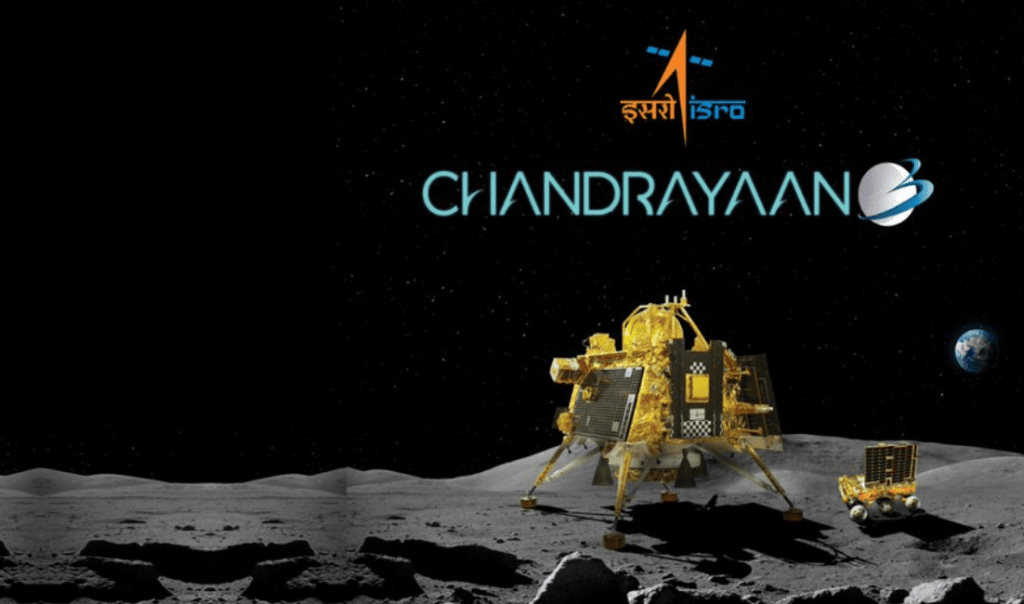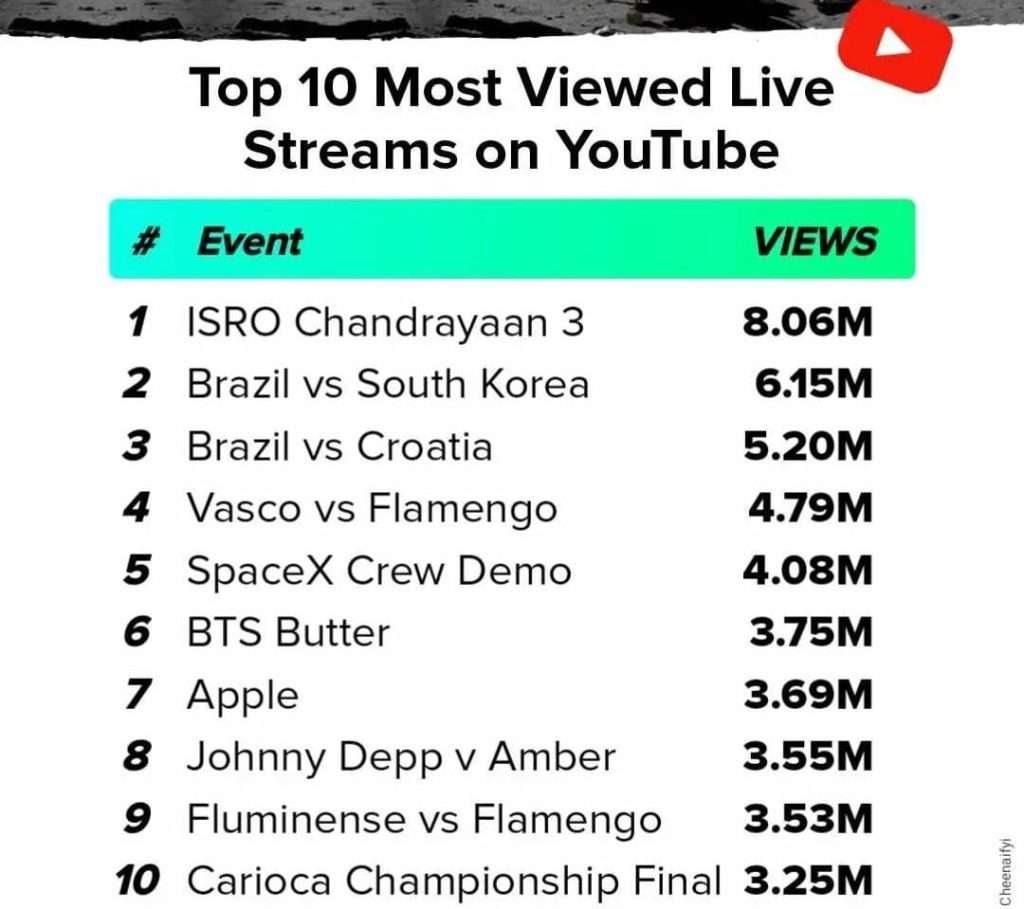On August 23 at 6.04 p.m. IST, the ISRO Chandrayaan 3 mission successfully touched down near the south pole of the Moon. This remarkable feat was accomplished by the Indian Space Research Organization (ISRO) as a follow-up to Chandrayaan-2, which unfortunately fell short of its intended goals.
The entire mission, from its development to its execution, was a testament to ISRO’s dedication and expertise. India makes a historic landing near the Moon’s south pole.

The space agency achieved a successful soft landing of the Chandrayaan 3 spacecraft near the Moon’s south pole, a region of great interest due to the possibility of water ice deposits.
The Whole Journey of ISRO Chandrayaan 3
- ISRO has announced that Chandrayaan 3 is scheduled for launch on July 14, 2023, from Sriharikota’s secondary pad. Mark your calendars for this highly anticipated event!
- ISRO successfully concluded vehicle electrical assessments on July 7.
- The space agency completed a 24-hour launch rehearsal on July 11, meticulously emulating the launch procedure to ensure precision and readiness.
- On July 14, the spacecraft embarked on its journey, propelled into its intended orbit by the mighty LVM3 M4 vehicle.
- Subsequent to that, a series of orbit-raising maneuvers occurred. Following the initial maneuver on July 15 (41,762 km x 173 km), there were three additional maneuvers on July 17 (41,603 km x 226 km), July 22 (71,351 km x 233 km), and July 25.
- Chandrayaan-3 successfully entered a translunar orbit (288 km x 369,328 km) on August 1st.
- Chandrayaan-3 was successfully inserted into lunar orbit on August 5 (164 km x 18074 km).
- On August 6th, the lunar orbit underwent a reduction to dimensions of 170 km by 4,313 km, bringing about a significant change in its trajectory.
- On August 9th, ISRO made adjustments to Chandrayaan 3 trajectory, ensuring it maintains a lunar orbit ranging from 174 km to 1,437 km.
- On August 14th, Chandrayaan 3 made significant progress by approaching the surface of the Moon, successfully entering into an orbit with dimensions of 150 km x 177 km. This remarkable achievement brings us closer to unlocking the secrets of our celestial neighbor.
- Next, the spacecraft executed its fifth and concluding lunar-bound maneuver, successfully establishing a circular orbit around the Moon at an altitude of 163 km by 153 km.
- On August 17th, the landing module, which encompasses the Vikram lander and Pragyan rover, successfully disengaged from its propulsion system.
- On August 18th, an operation called “deboosting” was carried out, adjusting the landing module’s orbit to a lower altitude of 113 km x 157 km.
- On August 20th, the spacecraft achieved both its highest and lowest points in orbit around the moon, covering distances of 134 km and 25 km respectively. This remarkable milestone signifies the furthest and nearest positions reached in relation to our lunar companion.
- The lunar touchdown commenced at 5:47 p.m. IST on August 23, gracefully achieving a soft landing by 6:04 p.m. IST.
Cost of Chandrayaan 3 Mission
The allocated budget for Chandrayaan 3 is set at Rs. 615 crore, notably lower than that of Chandrayaan 2. This indicates a consistent effort by ISRO to enhance efficiency and reduce costs. The budget covers everything from the spacecraft and launch vehicle to the essential ground support facilities. ISRO’s commitment to optimize resources and deliver within budget underscores its dedication to advancing space exploration.
Records Set by Chandrayaan 3
India has achieved a remarkable milestone by becoming the fourth country to conquer the uncharted south pole of Earth’s natural satellite. Additionally, the Chandrayaan-3 live stream on YouTube created history as it reportedly garnered unprecedented viewer engagement, making it the most viewed live stream worldwide.

- India has accomplished a historic feat by successfully landing a spacecraft near the lunar south pole, becoming the first country to do so. Additionally, India now ranks as the fourth country to softly land on the Moon. This remarkable achievement highlights India’s significant contributions in lunar exploration.
- More than 8 million people worldwide eagerly watched the live stream of the Chandrayaan-3 landing on YouTube, captivated by this historic event.
- ISRO has smashed the previous record of 60 lakh views clocked by YouTuber Casimiro during a 2022 FIFA World Cup quarterfinal match.
Chandrayaan 1 Mission
In October 2008, the Indian Space Research Organization (ISRO) embarked on an extraordinary lunar exploration mission with the launch of Chandrayaan-1. Comprising an orbiter and a Moon Impact Probe (MIP), this pioneering endeavor showcased India’s indigenous technology and propelled its space program to new heights. Lifted into lunar orbit on November 8, 2008, aboard the powerful PSLV-XL rocket, Chandrayaan-1 was poised to uncover the secrets of the Moon. Over its operational span until August 2009, this momentous undertaking from the Satish Dhawan Space Center in Sriharikota, Andhra Pradesh, not only bolstered India’s space prowess but also laid a solid foundation for future lunar aspirations.
\On November 14, 2008, the Moon Impact Probe separated from the Chandrayaan orbiter at 14:36 UTC and struck the south pole in a controlled manner. With the successful accomplishment of this mission, ISRO proudly joins the ranks of national space agencies that have achieved lunar landings. The former Soviet Union conquered the lunar surface in 1959, the United States in 1962, Japan in 1993, and ESA member states in 2006.
At exactly 15:01 UTC, the probe struck a spot near the Shackleton crater. The site of impact has been designated as Jawahar Point. Allow me to parlay its significance with precision and grace to enhance comprehension and aesthetics while preserving the original intent.
Cost of Chandryaan 1 Mission
The Chandrayaan 1 project was valued at ₹386 crore (equivalent to US$48 million). India’s lunar probe, affectionately known as the budget mission, aimed to explore the Moon while maintaining cost-effectiveness.
Chandryaan 2 Mission
The objective of the Chandryaan 2 Mission
The Chandrayaan-2 lander had two key objectives: first, to showcase the capability of soft-landing and remotely operating a robotic rover on the lunar surface. Second, the orbiter was designed to conduct scientific research on various aspects including lunar topography, mineralogy, elemental abundance, the lunar exosphere, as well as identifying hydroxyl and water ice signatures. This ambitious mission aimed to unravel the mysteries of the Moon’s composition and environment.
Why did Chandrayaan-2 fail?
A software glitch led to the failure of this particular component in the Chandrayaan-2 mission. After reaching an altitude of 2.1 kilometers above the Moon’s surface, Vikram, the lander, lost communication with the mission control station on Earth. Tragically, during the crash-landing on the Moon, both Vikram and Pragyan were destroyed.
Cost of chandrayaan 2 mission
The Chandrayaan-2 mission incurred a cost of Rs 978 crore for India. However, with the successful development of the launch vehicle and positioning of the orbiter, Chandrayaan-2 has significantly contributed to reducing the overall expenses associated with the Chandrayaan-3 mission.






